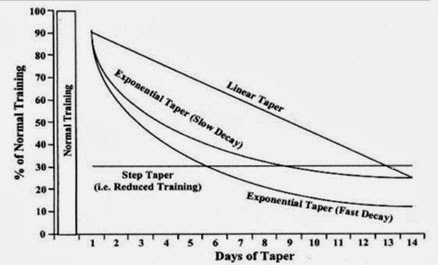There are many myths and misconceptions that surround the
concept of altitude training within the disciplines of exercise physiology and
sports training physiology. Such errors can lead to the misuse of training at
altitude, which may lead to disappointment in subsequent performance. This
article explores the subject of altitude training, defining what it is, acknowledging
potential problems and its ultimate impact upon athletic performance.
Altitude training can be defined as training at heights
greater than 2,500m above sea level. At such heights, it is commonly thought that there is a decreased percentage of atmospheric oxygen. However,
the percentage of gases in the air we breathe remains unchanged from sea level
to high altitude. Instead it is the partial pressure (PO₂) of each gas that is
reduced as a drop in atmospheric pressure is seen at altitude. Therefore the
air is less dense, consisting of less O₂, CO₂ and N₂ per litre, but the
percentage of each gas forming this litre does not change. The fall in PO₂
reduces the driving pressure for gas exchange at the lungs, accordingly
arterial O₂ saturations declines and so there is a rapid decline in O₂ availability to the
working muscles. From near sea level, to a moderate altitude VO₂ max observes a
linear reduction (Wehrlin and Hallen, 2006), on average this equates to -7.7% per
1000m of altitude despite a compensatory cardiorespiratory response.
It is this reduction in air density that can pose problems
to training at altitude if an athlete is not fully prepared, one such consequence is a
1°C fall in temperature for each 100m ascent. The combination of a decreased
temperature and pressure results in a reduced atmospheric water vapour content,
which leads to increased respiration due to a decreased oxygen availability.
This lends itself to greater water evaporation from the lungs, thus increasing
the likelihood of severe dehydration that will inevitably cause a deterioration
in athletic performance. As a result of these factors and a reduced cerebral O₂
saturation, many athletes suffer acute mountain sickness (AMS), the upshot of
which leads to a lack of appetite, nausea, excessive weakness, vomiting and
increased heart rate. Such symptoms dramatically impact upon the wellbeing of
an athlete and in severe cases pulmonary or cerebral oedema can ensue. In order
to prevent AMS a gradual introduction to altitude is needed, allowing for
acclimation to occur which can take up to two weeks for heights of 2300m. This
can be achieved through artificial means such as a hypoxic sleeping chamber or
nitrogen generator to lower the atmospheric O₂ content.
 |
| An example of a hypoxic sleeping chamber. |
Within the realm of sport and exercise science there has
been much debate as to whether the practice of altitude training can improve
aerobic performance. It has been hypothesized that the compensatory
physiological responses at altitude will result in adaptations that transfer to
improved sea-level performance. However, this has been seen to be untrue.
Altitude training has only been seen to cause performance improvements at
altitude, with the majority of studies confirming that altitude endurance
training fails to enhance sea-level performance. This outcome relates to the
inability to perform at a sufficiently high intensity at altitude, at a height
of 4000m exhaustion occurs at just 40% of sea level VO₂ max, thus failing to
elicit the relevant aerobic physiological adaptations. However, the live
high-train low rationale (Stray-Gundersen and Levine, 2008) provides hope for
the significance of the inclusion of altitude for athletes. This theory states
that the combined haematological adaptations from altitude and the maintenance
of training intensity at sea level results in an improved endurance performance
at sea level, giving leave to a 7.8% increase in O₂ carrying capacity. An
adaptation such as this is achieved by increases in red blood cell mass, haemoglobin
and erythropoietin, therefore increasing the delivery of oxygen to the working
muscles.
Overall it has been shown that the combination of living
high and training low can enhance sea level performance. This allows for a high
training intensity to be maintained whilst also attaining the important
haematological alterations that are associated with a high altitude.
References
Stray-Gundersen J., Levine B. D. (2008) Live high, train low
at natural altitude. Scandinavian Journal
of Medicine & Science in Sports. (1) pp. 21-28.
Wehrlin, J. P. and Hallen, J. (2006) Linear decrease in VO₂ max
and performance with increasing altitude in endurance athletes. European Journal of Applied Physiology (96)
pp. 404-412









